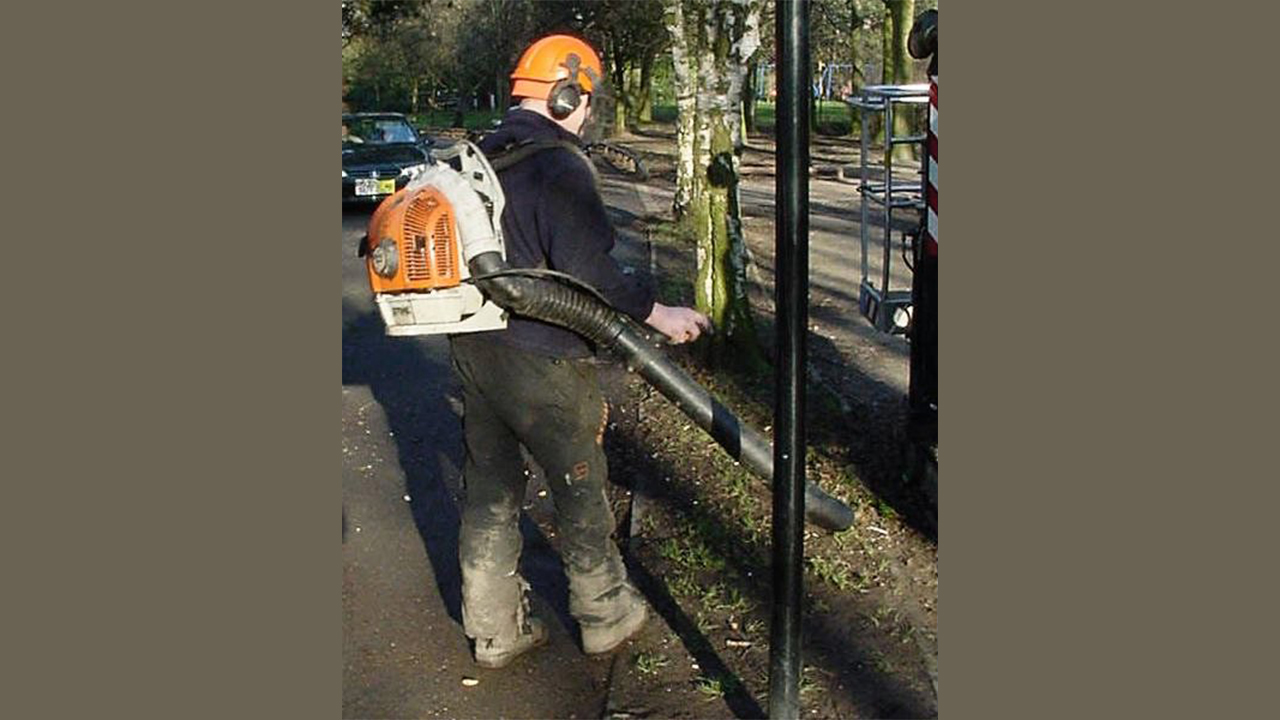
(Wiki-CC)
A Sunday school teacher taught me as a child that the Apocalypse would be ushered in by—among other signs—seven seals, seven trumpets, and seven bowls. A newspaper colleague once joked to me years ago that God had traded His seven horsemen for a phalanx of car stereos booming out bass-heavy hip-hop. Both were wrong. The sound of an authentic, almost perpetual Apocalypse has been with us for decades. It is tuned to cacophonic perfection in the infernal device we call the leaf blower, and its Satanic symphony of soul-crushing, aural agony will soon be upon us in full force.
Yes, sneering contempt for things we dislike on a personal basis is tiresome and common. Viewed objectively, leaf blowers fall squarely in the realm of “bourgeoise luxury problems,” or at least several levels below the struggle of finding affordable daycare or rent. But hear me out—unless, of course, the din leaf blowers have not already reached a full, terrifying crescendo—because the scientific consensus is that leaf blowers cost us far more than serene, outdoor strolls through neighborhoods and public parks. They also aim their pivoting wands straight against breathable air, urban bird and animal life, sustainable topsoil, and, quite likely, our mental and physical health.
Talk of “noise” unleashes a host of metaphors and similes. As in, noise from the upstairs neighbors, the alarm beep of trucks in reverse, or the nasal breathing of a co-worker. These count as annoyances. In the case of leaf blowers, by contrast, there is no choice but to resort to decibels (dB), and in that realm only rock concerts (120-129 dB) outdo the leaf blower. Circular saws (100 dB) and stereos (110 dB maximum) have at least the excuses of carpentry and music, respectively. Leaf blowers rip, claw, and tear at the veil of our urban soundscape at a roaring 95-115 dB without any excuse to forgive them. Not even the majority of construction equipment we pass on the road or highway register that loud.
These sound waves form a battering ram at the doors of our eardrums, violate the ossicles, assault our Eustachian tubes, plunder our cochleae, and trammel our auditory and cranial nerves into a deafening, helter-skelter submission. If silence is golden, leaf blowers are the sound of debts so large even oblivion struggles to contain them. Noise is the first destroyer of peace and, as such, ruins the small dreams and thoughts that live inside our heads during the day. Leafblowers assault our individual consciousness when we are subjected to them. When peace of mind escapes us depression, sleep deprivation, and even hypertension seep into our physical bodies. Rock concerts have the virtue of lasting no more than 120-150 minutes, with the option to leave should we grow tired or bored. Leaf blowers go beyond the simple definition of what economists politely term “externalities,” imposing their noise on us for durations of beginnings and endings we can never guess, let alone control, because homeowners and landscape companies never think to ask. Ask someone over the age of 50 about noise ordinance enforcements when they were growing up and they will likely tell you of penalties and enforcements that once held real teeth. Drivers in the not-so-distant past could be ticketed for loud mufflers. These days, chronic speeding and firearms offenses take precedence.
Leaf blowers are an ideal example of a device invented to solve one problem only to succeed marvelously in creating several more. Their impacts extend to birds and other urban animal life. Their supposed utility of clearing lawns of all leaves—since when did that become the right of homeowners’ anyway?—harms the soil and deprives insect life of their leaf-mulched habitat.
A skilled video editor could replace every chainsaw in The Texas Chainsaw Massacre with a two- or four-stroke, backpack-mounted leaf blower and the storyline would lose none of its blood-chilling horror. Leatherface would delight in torturing victims with his tool’s deafening roar, but perhaps not before they suffocate from its toxic emissions of benzene and nitrous oxides. As the marquee poster for the 1974 cult movie asks, “Who will survive and what will be left of them?”
If all this strikes you as playful hyperbole, consider that these devices are outright banned in at least 80 municipalities. Some curious souls wonder if there are instances in which leaf blowers qualify as assault weapons. Online petitions to ban leaf blowers abound, and well they should.
In the wake of this extended rant, however, let me invoke a solution of simple grace and true, old-fashioned convenience. Raking leaves produces a rhythmic, back-and-forth extension of the arms that grows tranquil with repetition, a bit like the forward-and-back motions of the legs while running. Raking produces a rustling, serene friction between crisp, crunchy leaves and the rake’s tines. Rakes, and the act of raking, let fallen leaves speak to us in the original music of the fall season. Rake, and you will not need faux fall accouterments such as pumpkin spice lattes or designer scarves to match the bizarre sight of a fall-season lawn sans the soothing sight of orange and tan leaves. You will have your rake. You will have a soul. And you will have a true fall season.
